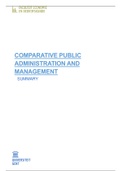Samenvatting
Samenvatting vergelijkende bestuurskunde en publiek management
Samenvatting van vergelijkende bestuurskunde en publiek management uit het masterjaar bestuurskunde en publiek management. De samenvatting is een combinatie van het boek, de powerpoints en notities. Heel af en toe staat er eens plots een lege plek op het blad, dat is omdat de figuur uit de ppt niet...
[Meer zien]



